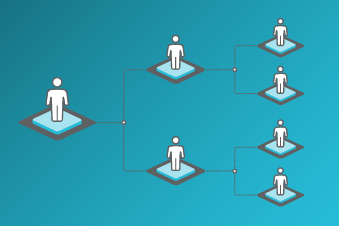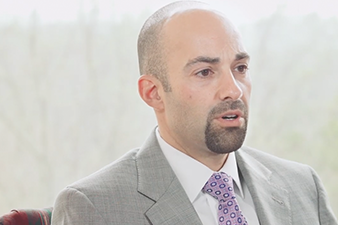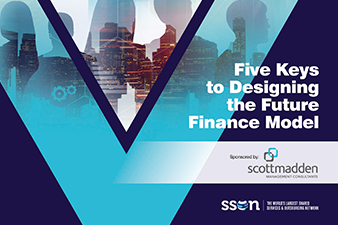
In “Robotic Process Automation: Innovative Transformation Tool for Shared Services,” we introduced the transformational tool called Robotic Process Automation (RPA). This software addresses numerous challenges for corporate and shared services as an efficient, cost-effective alternative to traditional process approaches. RPA implementations are increasing in popularity due to the money and resources RPA saves businesses over time. Once you decide that RPA is the right process solution for your needs, ScottMadden can help you develop a customized strategy to ensure a successful implementation.
The Path to RPA Success
There are numerous factors to consider when starting an RPA implementation. While each RPA process depends on the needs and maturity of your organization, implementation typically includes the following phases:
- Phase 1 – Assess for RPA Opportunities
- Phase 2 – Select a Vendor
- Phase 3 – Capture Process Steps, Pilot, and Implement
- Phase 4 – Manage the RPA Lifecycle
RPA Implementation Process

Phase 1 – Assess for RPA Opportunities
A successful implementation begins by finding the processes in your business that could benefit from RPA. To begin, conduct a high-level assessment of the potential process candidates for automation and document the resulting efficiencies and cost-savings opportunities to confirm whether RPA is a good fit. Every process in the company may not be suitable for RPA implementation. This initial step determines which areas will benefit the most by switching to RPA. This savings baseline is the starting point for internal discussions with stakeholders to spark interest and obtain direction. Most importantly, this phase includes technology demonstrations by selected RPA vendors to serve as a proof of concept and platform for knowledge gathering.
Once you have outlined the scope for applying this technology, the crucial next step is to define the objectives of the RPA initiative. It is important to gain agreement from executive stakeholders on project objectives, which determine the project roles, responsibilities, and plans for the remaining phases. From our experience, this initial collaboration and buy-in pays major dividends during the remainder of the implementation. The biggest mistake companies make during this phase is trying to avoid risk by selecting benign processes without significant business impact. This results in unattractive business cases for the very stakeholders from whom you are seeking approval.
Phase 1 Key Tasks
- Conduct research on RPA services and vendor capabilities
- Identify project details
- Project team members and responsibilities (i.e., stakeholders, SMEs, evaluators)
- Project plan/governance/risks
- Set project objectives
- Report out to stakeholders periodically for guidance and strategic direction
- Agree upon process candidate guiding principles (e.g., high volume, static, impact, etc.)
- Review a preliminary set of process candidates for use cases and document benefits of potential automation
- Identify preliminary list of RPA process candidates and software vendors
Phase 2 – Select a Vendor
Phase 2 involves the steps for selecting an RPA provider, starting with gaining agreement on the technical requirements and evaluation criteria. The selection process, often through a request for proposal approach, is an opportunity for vendors to show you how they meet your requirements.
During this phase, refine your procurement strategy by inviting RPA vendors (who meet your list of technical requirements and mandatory criteria) to participate in onsite presentations. Many vendors will agree to demonstrate applying RPA to your selected processes as a proof of concept. These onsite presentations should include a technical demo with a specific focus on the functionality found in each use case, or the process which the RPA is replacing, so that you can evaluate the different solutions.
Then, select a vendor based on the best fit across the technical requirements, onsite presentation and/or proof of concept, and financial business case. Many RPA vendors will conduct the configuration and test for you, while others will sell “bot” licenses and teach you to implement yourself. Most still provide both services. Many companies choose the former for the pilot, but develop in-house expertise to “do it yourself” for future projects. What’s the best fit for you? We believe companies would be best served by contracting a vendor to code the initial pilot to determine if a vendor is needed for further implementations or if an internal RPA center of expertise could handle the subsequent implementations (i.e., if company sees a longer-term future in RPA).
Phase 2 Key Tasks
- Finalize use case(s) for vendors to respond to and potentially demonstrate
- Establish process requirements, vendor evaluation criteria, and technology requirements, e.g., access rights, source systems, etc., necessary to support the initiative
- Develop and issue a request for proposal to selected vendors
- Evaluate responses (mandatory criteria/technical requirements) to select eligible providers to be invited to the onsite presentation and technical demo phase of the procurement process
- Execute onsite presentations with designated vendors and utilize financial proposal of selected vendors to create the RPA business case
- Award the pilot to the highest-evaluated vendor
Phase 3 – Capture Process Steps, Pilot, and Implement
This phase includes the activities necessary to prepare and execute the selected RPA solution. In this phase, you need to ensure that your human capital resources are trained and ready to execute the implementation plan. This phase also involves supporting and testing the IT environment. Additionally, the implementation activities will need to be documented, tracked, and completed per the plan.
Phase 3 includes the facilitation of your pilot for the selected use case(s)/process area. During this step, you will explore the end-to-end automation of each selected use case to showcase the full extent of the RPA technology. If any errors occur, now is the time for refinement and final modifications prior to the stakeholder review. This phase establishes the groundwork for future state operational models for a smooth transition into the long-term RPA strategy defined in Phase 1 and managed in Phase 4.
Phase 3 Key Tasks
- Support the project management of the detailed implementation plan
- Determine additional requirements, if any, necessary to support the pilot
- Conduct readiness assessment
- Execute pilot with your selected vendor
- Mitigate any resulting issues as necessary
- Finalize your benefit model (business case)
Phase 4 – Manage the RPA Lifecycle
Now is the time to launch your successful RPA solution. Phase 4 includes the initial launch of your RPA, as well as planning for the ongoing success of your RPA software through proactive maintenance. Your strategy should include the governance, operating model, organizational structure, and change management plan of your RPA solution.
Phase 4 Key Tasks
- Put the final strategic model in place (e.g., chargeback mechanisms, creation of RPA center of expertise, etc.)
- Determine the operating model, governance, and process prioritization system
- Manage the ongoing change management and communication plan
Conclusion – Keys to Success
RPA is a powerful transformation tool that can improve your business as long as you take the proper steps to execute a smart implementation strategy. While the purpose of RPA is to transfer certain processes from humans to bots, your human capital is pivotal to a successful transition. Each step of the RPA process must be communicated to your team so that the execution is smooth and deliberate. If your employees understand each step of the implementation, including the areas susceptible to mistakes, you will be able to limit the margin of error as you proceed. Human capital remains a valuable asset post-implementation as well. Your IT department will need to understand the new technology in order to maintain the RPA, educate others, and continue to update the technology as RPA evolves. Consider the following keys to success for your implementation:
- Choose the right project team, both internal and external – Per the Shared Services and Outsourcing Network (SSON), RPA Summit 2016 survey, “64% of respondents stated that they felt people were central to RPA implementation.” While it is crucial to pick the right technology and implementation partners, it is equally important to be deliberate in your selection of the project team and stakeholders.
- Execute detailed work plans to ensure no work is dropped – In order to ensure success across the board, new work streams should start at the same time. Pay special attention to transition steps and cutover plans and prepare readiness assessments. Each of these factors will improve your management of the changeover by reducing risk of process cycle time increases before implementation is complete.
- Strong, sustained leadership and sponsorship – From our diverse experience leading technology assessment/implementation projects, we have learned the tremendous importance of sustained leadership support. Leadership buy-in cannot be overstated, and sharing an aligned vision greatly improves project performance and transition efficiency.
- Early connection with IT, controls, and procurement – Since RPA is a relatively new technology, we have learned that it is extremely important to educate IT on the pros/cons and risks of RPA. Establishing relationships with IT, controls, and procurement early will help overcome the obstacles inherent in implementing a pilot program for this evolving technology.
SCOTTMADDEN FOR RPA CONSULTATION
ScottMadden is proud to work with our clients on innovative concepts and state-of-the-art technology programs that enhance effectiveness and efficiency. We have worked with several well-known companies to oversee these RPA implementation steps. Our knowledge of shared services models and processes brings particular value into the strategy, process prioritization, and vendor selection. We can oversee the entire process, serving as an objective guide without formal alliances to vendors or business process outsourcer providers.
ABOUT THE AUTHORS
Brad DeMent (bdement@scottmadden.com) is a partner in the Atlanta office and leads the Finance practice. Trey Robinson (treyrobinson@scottmadden.com) is a partner in the Raleigh office. Jonathan Harb (jonathanharb@scottmadden.com) is a senior associate in the Atlanta office. Todd Kennedy (toddkennedy@scottmadden.com) is a senior associate in the Atlanta office.
External Sources
- “Automate This – The Business Leader’s Guide to Robotic and Intelligent Automation,” Peter Lowes and Frank Cannata, 2015
- “The State of Robotic Process Automation and Artificial Intelligence in the Enterprise,” collaboration of Process Excellence Network, RPA & AI Summit 2016, and SSON 2016
- “Robotic Process Automation: The Next Transformation Lever for Shared Services,” Mary Lacity and Leslie Willcocks, 2015
























































